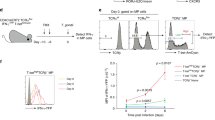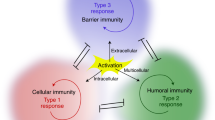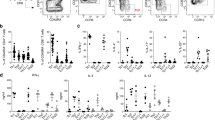Abstract
Activated T lymphocytes differentiate into effector cells tailored to meet disparate challenges to host integrity1. For example, type 1 and type 2 helper (TH1 and TH2) cells secrete cytokines that enhance cell-mediated and humoral immunity, respectively. The chemokine monocyte chemoattractant protein-1 (MCP-1) can stimulate interleukin-4 production2 and its overexpression is associated with defects in cell-mediated immunity3, indicating that it might be involved in TH2 polarization. Here we show that MCP-1-deficient mice are unable to mount TH2 responses. Lymph node cells from immunized MCP-1-/- mice synthesize extremely low levels of interleukin-4, interleukin-5 and interleukin-10, but normal amounts of interferon-γ and interleukin-2. Consequently, these mice do not accomplish the immunoglobulin subclass switch that is characteristic of TH2 responses and are resistant to Leishmania major. These effects are direct rather than due to abnormal cell migration, because the trafficking of naive T cells is undisturbed in MCP-1-/- mice despite the presence of MCP-1-expressing cells in secondary lymphoid organs of wild-type mice. Thus, MCP-1 influences both innate immunity, through effects on monocytes, and adaptive immunity, through control of T helper cell polarization.
This is a preview of subscription content, access via your institution
Access options
Subscribe to this journal
Receive 51 print issues and online access
$199.00 per year
only $3.90 per issue
Buy this article
- Purchase on Springer Link
- Instant access to full article PDF
Prices may be subject to local taxes which are calculated during checkout





Similar content being viewed by others
References
Abbas, A. K., Murphy, K. M. & Sher, A. Functional diversity of helper T lymphocytes. Nature 383, 787–793 (1996).
Karpus, W. J. et al. Differential CC chemokine-induced enhancement of T helper cell cytokine production. J. Immunol. 158, 4129–4136 (1997).
Rutledge, B. J. et al. High level monocyte chemoattractant protein-1 expression in transgenic mice increases their susceptibility to intracellular pathogens. J. Immunol. 155, 4838–4843 (1995).
Matsushima, K., Larsen, C. G., DuBois, G. C. & Oppenheim, J. J. Purification and characterization of a novel monocyte chemotactic and activating factor produced by a human myelomonocytic cell line. J. Exp. Med. 169, 1485–1490 (1989).
Yoshimura, T. et al. Purification and amino acid analysis of two human glioma-derived monocyte chemoattractants. J. Exp. Med. 169, 1449–1459 (1989).
Carr, M. W., Roth, S. J., Luther, E., Rose, S. S. & Springer, T. A. Monocyte chemoattractant protein 1 acts as a T-lymphocyte chemoattractant. Proc. Natl. Acad. Sci. USA 91, 3652–3656 (1994).
Allavena, P. et al. Induction of natural killer cell migration by monocyte chemotactic protein-1, -2 and -3. Eur. J. Immunol. 24, 3233–3236 (1994).
Maghazachi, A. A., al-Aoukaty, A. & Schall, T. J. C-C chemokines induce the chemotaxis of NK and IL-2-activated NK cells. Role for G proteins. J. Immunol. 153, 4969–4977 (1994).
Fuentes, M. E. et al. Controlled recruitment of monocytes/macrophages to specific organs through transgenic expression of MCP-1. J. Immunol. 155, 5769–5776 (1995).
Nakamura, K., Williams, I. R. & Kupper, T. S. Keratinocyte-derived monocyte chemoattractant protein 1 (MCP-1): analysis in a transgenic model demonstrates MCP-1 can recruit dendritic and Langerhans cells to skin. J. Invest. Dermatol. 105, 635–643 (1995).
Gunn, M. D., Nelken, N. A., Liao, X. & Williams, L. T. Monocyte chemoattractant protein-1 is sufficient for the chemotaxis of monocytes and lymphocytes in transgenic mice but requires an additional stimulus for inflammatory activation. J. Immunol. 158, 376–383 (1997).
Lu, B. et al. Abnormalities in monocyte recruitment and cytokine expression in monocyte chemoattractant protein 1-deficient mice. J. Exp. Med. 187, 601–608 (1998).
Gu, L. et al. Absence of monocyte chemoattractant protein-1 reduces atherosclerosis in low density lipoprotein receptor-deficient mice. Mol. Cell 2, 275–281 (1998).
Gosling, J. et al. MCP-1 deficiency reduces susceptibility to atherosclerosis in mice that overexpress human apolipoprotein B: a critical role for chemokines in monocyte recruitment and foam cell formation. J. Clin. Invest. 103, 773–778 (1999).
Gonzalo, J. A. et al. The coordinated action of CC chemokines in the lung orchestrates allergic inflammation and airway hyperresponsiveness. J. Exp. Med. 188, 157–167 (1998).
Loetscher, P., Seitz, M., Baggiolini, M. & Moser, B. Interleukin-2 regulates CC chemokine receptor expression and chemotactic responsiveness in T lymphocytes. J. Exp. Med. 184, 569–577 (1996).
Chensue, S. W. et al. Monocyte chemotactic protein expression during schistosome egg granuloma formation. Sequence of production, localization, contribution, and regulation. Am. J. Pathol. 146, 130–138 (1995).
Karpus, W. J., Kennedy, K. J., Kunkel, S. L. & Lukacs, N. W. Monocyte chemotactic protein 1 regulates oral tolerance induction by inhibition of T helper cell 1-related cytokines. J. Exp. Med. 187, 733–741 (1998).
Sallusto, F., Lanzavecchia, A. & Mackay, C. R. Chemokines and chemokine receptors in T-cell priming and Th1/Th2-mediated responses. Immunol. Today 19, 568–574 (1998).
Bonecchi, R. et al. Differential expression of chemokine receptors and chemotactic responsiveness of type 1 T helper cells (Th1s) and Th2s. J. Exp. Med. 187, 129–134 (1998).
Boring, L. et al. Impaired monocyte migration and reduced type 1 (Th1) cytokine responses in C-C chemokine receptor 2 knockout mice. J. Clin. Invest. 100, 2552–2561 (1997).
Warmington, K. S. Effect of C-C chemokine receptor 2 (CCR2) knockout on type-2 (schistosomal antigen-elicited) pulmonary granuloma formation: analysis of cellular recruitment and cytokine responses. Am. J. Pathol. 154, 1407–1416 (1999).
Schecter, A. D. et al. Tissue factor is induced by monocyte chemoattractant protein-1 in human aortic smooth muscle and THP-1 cells. J. Biol. Chem. 272, 28568–28573 (1997).
Nibbs, R. J. B., Wylie, S. M., Pragnell, I. B. & Graham, G. J. Cloning and characterization of a novel murine beta chemokine receptor, D6. Comparison to three other related macrophage inflammatory protein-1alpha receptors, CCR-1, CCR-3, and CCR-5. J. Biol. Chem. 272, 12495–12504 (1997).
Power, C. A. et al. Molecular cloning and functional expression of a novel CC chemokine receptor cDNA from a human basophilic cell line. J. Biol. Chem. 270, 19495–19500 (1995).
Imai, T. et al. The T cell-directed CC chemokine TARC is a highly specific biological ligand for CC chemokine receptor 4. J. Biol. chem. 272, 15036–15042 (1997).
Kelder, W., McArthur, J. C., Nance-Sproson, T., McClernon, D. & Griffin, D. E. Beta-chemokines MCP-1 and RANTES are selectively increased in cerebrospinal fluid of patients with human immunodeficiency virus-associated dementia. Ann. Neurol. 44, 831–835 (1998).
Conant, K. et al. Induction of monocyte chemoattractant protein-1 in HIV-1 Tat-stimulated astrocytes and elevation in AIDS dementia. Proc. Natl. Acad. Sci. USA 95, 3117–3121 (1998).
Rollins, B. J., Morrison, E. D. & Stiles, C. D. Cloning and expression of JE, a gene inducible by platelet-derived growth factor and whose product has cytokine-like properties. Proc. Natl Acad. Sci. USA 85, 3738–3742 (1988).
Gunn, M. D. et al. A chemokine expressed in lymphoid high endothelial venules promotes the adhesion and chemotaxis of naive T lymphocytes. Proc. Natl Acad. Sci. USA 95, 258–263 (1998).
Acknowledgements
We thank A. Abbas, C. Gerard, R. Ransohoff and E. Reinherz for helpful comments and advice; P. Marks, L. Clayton and C. Daly for assistance; A. Satoskar and J. David for Leishmania major; and the staff of the Animal Resource Facility at Dana-Farber Cancer Institute for their humane animal care. Supported by NIH grants to B.J.R., who is also a Scholar of the Leukemia Society of America and is supported by the Novartis/Dana-Farber Drug Discovery Program.
Author information
Authors and Affiliations
Corresponding author
Rights and permissions
About this article
Cite this article
Gu, L., Tseng, S., Horner, R. et al. Control of TH2 polarization by the chemokine monocyte chemoattractant protein-1. Nature 404, 407–411 (2000). https://doi.org/10.1038/35006097
Received:
Accepted:
Issue Date:
DOI: https://doi.org/10.1038/35006097
This article is cited by
-
Predictive value of CCL2 in the prognosis and immunotherapy response of glioblastoma multiforme
BMC Genomics (2023)
-
Pre-infection plasma cytokines and chemokines as predictors of HIV disease progression
Scientific Reports (2022)
-
Mesenchymal stem cells empower T cells in the lymph nodes via MCP-1/PD-L1 axis
Cell Death & Disease (2022)
-
Expression levels of MCP-1, HGF, and IGF-1 in endometriotic patients compared with non-endometriotic controls
BMC Women's Health (2021)
-
Predicting the allergenicity of legume proteins using a PBMC gene expression assay
BMC Immunology (2021)
Comments
By submitting a comment you agree to abide by our Terms and Community Guidelines. If you find something abusive or that does not comply with our terms or guidelines please flag it as inappropriate.



